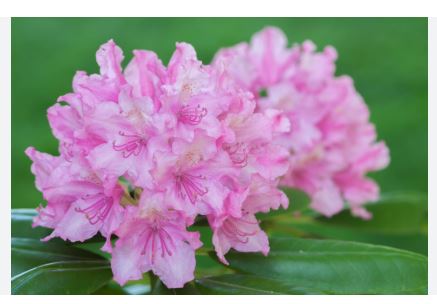
Rhododendron macrophyllum, commonly known as the Coast Rhododendron or Pacific Rhododendron, is a member of the Rhododendron genus within the Ericaceae family, which is also known as the heath or heather family. This species is characterized by its large, leathery leaves and showy, bell-shaped flowers. The species name “macrophyllum” is derived from Greek, meaning “large-leaved,” which describes one of its prominent features.
The Coast Rhododendron is native to the Pacific Northwest of North America, with its range extending from British Columbia in Canada, south through Washington, Oregon, and into parts of California. It flourishes in coastal and mountain forest habitats, often found in the understory of coniferous forests where it benefits from the partial shade and the acidic, well-drained soils typical of these regions.
Historically, Rhododendron macrophyllum has had cultural significance among Native American tribes in its native range. It was used for medicinal purposes, with the leaves and bark applied to treat various ailments like colds and rheumatism. Its aesthetic appeal also made it a subject of interest for early settlers and botanists, leading to its widespread use in horticulture as one of the first North American rhododendron species to be cultivated. Its beauty and the dense clusters of pink to lavender flowers have made it a symbol of the Pacific Northwest’s natural heritage, often celebrated in regional festivals and gardens.
Coast Rhododendron is well-adapted to USDA Hardiness Zones 7 through 9. This range reflects its ability to handle both the mild, wet winters and the relatively cool, often foggy summers of the Pacific Northwest. As for lifespan, Rhododendron macrophyllum can live for many decades, with some specimens reaching over 100 years under optimal conditions. Its longevity is supported by its slow growth rate, deep root system, and adaptation to its native environment, although this can vary based on cultivation practices, soil conditions, and climate changes.
Coast Rhododendron (Rhododendron macrophyllum ): Characteristics
- Flower Appearance: Displays large, bell-shaped flowers in clusters, which can range from pale pink to deep rose or lavender, sometimes with a yellow or greenish blotch inside. Flowers are notably fragrant.
- Bloom Time: Blooms in late spring to early summer, providing a spectacular display that can last for several weeks, adding color and fragrance to forest understories and gardens.
- Growth Habit: Grows as a large, multi-stemmed shrub, reaching heights of 6 to 20 feet, with a broad, often rounded shape. In its native habitat, it can form dense thickets.
- Leaves: Features large, evergreen leaves that are thick, leathery, and glossy, measuring 3 to 8 inches long. They are dark green above and lighter below with an oval shape, contributing to year-round interest.
- Root System: Has a shallow but wide-spreading root system, which is typical of rhododendrons, allowing it to absorb nutrients and moisture from the surface layers of acidic, well-drained soils.
- Adaptability: Prefers partial shade to full sun in cooler climates, requiring acidic, well-drained soil. It’s less tolerant of hot, dry conditions and alkaline soils.
- Pollinator Attraction: Attracts bees, butterflies, and hummingbirds with its nectar-rich flowers, playing an important role in local ecosystems by supporting pollinators.
- Fragrance: Emits a sweet, spicy fragrance when in bloom, which can be quite noticeable in woodland settings or gardens.
- Toxicity: All parts of the plant are toxic if ingested, containing grayanotoxins which can cause symptoms ranging from nausea to more severe reactions in humans and animals.
- Ecological Role: Acts as an important understory plant in Pacific Northwest forests, providing habitat and food sources for wildlife, contributing to soil stabilization, and offering shelter in its dense growth.
Coast Rhododendron (Rhododendron macrophyllum ): Cultivation
Site Selection
Choose a site with partial shade, especially in warmer climates, though it can tolerate full sun if adequately watered and not subjected to extreme heat. Mimic its natural habitat with dappled light.
Soil Preparation
Requires acidic, well-drained soil. Amend soil with organic matter like composted pine needles or peat moss to lower pH if necessary. Good drainage is crucial to prevent root rot.
Planting
Plant in spring or early fall to avoid extreme temperatures. Dig a hole twice as wide as the root ball but no deeper. Ensure the root ball sits just above or level with the soil surface to prevent water accumulation around the roots.
Watering
Water thoroughly after planting, and keep soil consistently moist but not waterlogged. Rhododendrons have shallow roots and require regular watering, especially during dry spells, but avoid overwatering.
Mulching
Apply a layer of acidic mulch (e.g., pine bark, wood chips) to help retain soil moisture, maintain soil acidity, and suppress weeds. Keep mulch away from the stem to prevent rot.
Fertilization
Fertilize in early spring with a slow-release, acid-loving plant fertilizer. Avoid high-nitrogen fertilizers which can promote leaf growth at the expense of flowers.
Pruning and Maintenance
Prune just after flowering to shape or remove dead or diseased wood. Avoid heavy pruning as it blooms on old wood. Deadheading can encourage more vigorous growth for the next season.
Pest and Disease Management
Watch for common rhododendron pests like lace bugs, weevils, and fungal diseases in wet conditions. Good air circulation, proper watering, and avoiding overcrowding can prevent many issues. Use targeted treatments if problems arise.
Propagation
Can be propagated by seeds, but this is time-consuming and less reliable for maintaining desired traits. Layering or taking semi-hardwood cuttings in late summer to early fall is more effective.
Winter Care
In its hardiness zones, no special winter care is typically needed. However, in colder parts of its range or during unusually harsh winters, a protective mulch layer can help shield roots from freezing.